
My Mother's Journal |
| A Memoir by the Late Elizabeth (Bryan) McCabe |
| Edited by her daughter, Aimee McCabe-Walker |
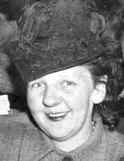 |
| Elizabeth (Bryan) McCabe |
The Importance of Your Personal History. Around 1970 or so, I asked my Mother to begin writing her Personal History. I am so glad that she did! She wrote about many things that I had not heard about. She passed away in 1996. I have put all of her writings into a Word document which I named Journal. It is full of historical data as well as a chronicle of her life and mine too.
If you know of anyone who lived in the Washington, D.C. area during the early days, I would love to hear their stories. Consider writing your Personal History! I have begun writing mine! My children and their children will have something to read and pass on to future generations. --Aimee McCabe-Walker
My mother Charlotte Lucinda Mawrey-Bryan, passed away October 15, 1918, at age 45 of the Flu epidemic which killed over 20 million world wide. I was 4 years old. Brother, Raymond Mawrey Bryan also died of this epidemic, on October 10, 1918. He was only sixteen years old.
My father’s name was William Wilson Bryan. Born March 18, 1874 in Staunton, VA. He passed away in 1956. He worked for the United States Post Office as an armed guard in Washington, D.C.
It was a warm night and my father and sister, (Ruth Lydia Bryan-Murray) were waiting in the front yard for me to be born. I finally arrived around 2am.
Earliest Memories. I do not recall too much of my life as a very young child. I do remember my mother asking my brothers and sister to please close the door. No one did, so I climbed out of the crib and shut the door and climbed back into my crib again. Another time, we were all standing around the little gas stove and my mother was melting cheese on saltines and giving us each some.
The Flu Epidemic. My brother, Raymond Mawrey Bryan, caught the Spanish flu. He was only sixteen years old and worked for the Red Cross. He got wet and didn’t change into dry clothes. He died on October 10, 1918. My mother caught it and died five days later on October 15, 1918. Twenty million died of this worldwide flu epidemic.
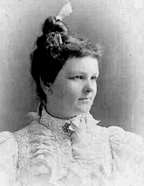 |
| Elizabeth's mother, Charlotte |
Aunt Bessie promised my mother she would take good care of me. I remember being carried in to kiss my mother good-bye. I was four years old.
She took real good care of me. She fed me and made me pretty clothes. She taught me to sing and I brushed her long brown hair. She took me to Woolworth’s on Saturdays and she would treat me to a hot dog and a banana split. Aunt Bessie passed away and I went to live with aunt Eva. Very traumatic times.
Slate and Slate Pencil. My first day at school and there were no pencils or paper. It was September 1920. The teacher Said to tell your parents to get us a slate and slate pencils.
I told my Aunt Eva that I needed a slate and pencils. She went to the hall closet and brought down a package all wrapped in heavy brown paper and twine. She cut the twine and unwrapped it. There were three slates bolted together with a white slate pencil in between each slate. She took out the bolts and there to my surprise was handwriting in pink, blue, yellow and white. My Aunt said they were messages from my Grandfather’s relatives and friends who had died. Many were from England where his parents came from in the early 1800’s.
My grandfather liked to go to seances and he took the slates all wrapped and never let them out of his sight. When he returned home, he opened it up and read all the messages. I often wonder what was written. I could not read then. My aunt gave me a slate and pencils and I took them to school the next day. I wish I knew how they got there.
Jeanette Rankin - First Congresswoman 1916 - Montana. She voted against entering World War I. While I was a student at Dennison School, Washington, D.C., Jeanette Rankin came and talked to my class about her vote against entering World War I. I was in the fourth grade and we all had to write a composition about it.
Even then, I felt men should talk it over and solve their problems without resorting to going to war and killing and maiming our youth. We are all told that we should get along and not fight or leave the room. We would be punished for disrupting the class. Even today, there is too much emphasis on weapons. Spending money, our money on nuclear bombs, fighter jets and other military items that should be used to better purposes, such as health and education.
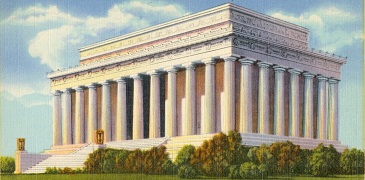 |
| Lincoln Memorial |
Roller Skating Around Washington, D.C. I remember my first pair of roller skates. They were Union made and they had clamps to fasten to the soles of my shoes. I skated all over my neighborhood and even skated down to the Lincoln Memorial and Washington Monument. It was downhill going but uphill coming home.
I skated until I was almost eighteen. I skated by the Synagogue and one of my friends was standing outside with her friends. She was very upset with me for skating on her holiday.
Tennis! I bought my first tennis racquet for one dollar and ninety eight cents. I saved my allowance and bought two tennis balls. I made an imaginary line on the outside wall of our apartment. I hit the ball over that line. One day I started playing tennis with a brother of one of my classmates. We found deserted tennis courts and we would play a game of tennis or two. We would each put in a nickel any buy a big sour pickle. It would sure taste good after playing tennis on a warm day.
Art Classes and the Washington Post. I took art classes with Mrs. May Ashton. I did a big charcoal drawing of "Three That Are Blind and Two That Can See". I re did it in water colors and it was hung at the top of the stairs at the "House of Seven Arts". The Washington Post took my picture standing beside it. It was in the paper. I lost it because of our moving so often.
Washington, D.C. During the 1920’s and early 1930’s. Living in Washington, D.C. was so different than it is today. One could ride a street car from one end of town to the other. Housing stopped at Florida Avenue. Henderson Castle was on one side of 16th Street, N.W. and Meridian Park was across the street.
The Henderson Castle. The castle was very authentic. Red bricks and red cement blocks. The wall was a good three stories high and there were openings for guns and at the entrance there was a jail with iron bars. The castle itself, was on top of a big hill. Often I would see Mrs. Henderson working in her garden. She was a tiny lady, always dressed in long black dresses. There was a swimming pool and tennis courts.
The Hendersons came from one of the New England States. He was a Senator and his wife was very much involved in the social life of the Nation’s Capital. Although she would not serve alcoholic beverages, she was a very popular hostess. The society folks came to her parties to enjoy the surroundings.
When she and her husband passed away, the city tried to make the castle into a home for single girls during the New Deal Era. Unfortunately the plumbing was hardly adequate. It was torn down and a modern building was built to accommodate all the young ladies who came to work for the New Deal agencies. I wish something like that had been available when I went to work for the Resettlement Administration.
They did build a new, modern YWCA building after I married. They only let the young ladies live there just a few years, and then they had to find a place to live elsewhere. When I lived at the old YWCA there were women who moved there during the First World War.
During the 1920’s and ‘30’s there were open spaces beyond Meridian Park. Horses and carriages were replaced with limousines with uniformed chauffeurs who stood by waiting for their owners to return.
The Italian Embassy. It was different. On top of a one story building they put umbrella tables and chairs, flowers, balloons whenever they entertained. Very festive! Whenever I skated or walked by, I was amazed at the informality.
The Canadian Legislation, Force School classes from sixth to eighth grades, was next to my school. One day, some dignitary came and we were allowed to look out the window (of our classroom) to see the footman all dressed in baby blue satin jacket, lace shirt and cream satin breeches, silk stockings and blue shoes. He looked very elegant. He opened the door to the horse drawn carriage and helped a man of importance out of the carriage and up the steps.
Shopping in the 1920’s. It was a chore. Especially since I was only nine or ten years old. My Aunt Eva sent me to the store. She never left the apartment. We lived on the fourth floor, so it was up to me to get whatever groceries we needed. My sister, Ruth, who was seven years older, was never asked to do anything. She believed if she never learned, she wouldn’t have to do anything.
Aunt Eva gave me a list and the exact amount of money needed to do the grocery shopping. If chuck roast was 25 cents a pound, she would give me one dollar and expected exactly four pounds. The butcher did not like to see me coming. It was impossible for him to cut meat to weigh exactly four pounds.
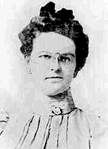 |
| Aunt Eva |
Aunt Eva Was Not Much of an Everyday Cook. Aunt Eva cooked cabbage until it was black. She did make a delicious coconut layer cake. We had a big market not too far away. There were individual stands. I would go to the stand that ground fresh coconut. Than I would be sent to "O" Street Market to buy buckwheat flour. We either had buckwheat pancakes made with yeast or kidney stew and a hot roll for Sunday breakfast.
Church and Sunday School. My sister, Ruth, and I were sent to Luther Place Memorial Church for Sunday School and stayed for church services. I would be starving by the time it was all over and I invariably fell over and fainted. No one could understand why I fainted. I was too shy to say it was because I was hungry. We had breakfast after church.
Suicide Prevention. One morning, 3am, my Aunt Eva awakened me, saying "Hurry, get up! Earle, (Aunt Eva’s son) has gone out and swore he would commit suicide." I dressed as fast I could and ran down the four flights of stairs. I caught up with him and we walked and walked down Sixteenth Street and then down Constitution Avenue. He never said a word as we walked. I was glad it was a clear night. Earle was about forty years old and almost blind. He had never worked. He was spoiled and bad tempered.
We finally got to the Lincoln Memorial and sat with our legs hanging over the side. We sat there and watched the sun rise, and the sky became brilliant red, orange and golden in colors. Earle finally got up and then I got up and we started walking back home. It was all uphill. I ate breakfast and went to school. I fell asleep. The teacher couldn’t understand why I was so sleepy. I couldn’t very well tell her why.
The Christmas Pageant. Every Christmas, I took part in the Pageant. "The Other Wise Man." We had to take our dresses, shoes, socks and coats off and put on colorful rags. We dressed in a building adjoining the church. It seemed to always be snowing or raining and we had to run through rain and puddles. Then run down the church aisle screaming. I never did get to see the whole pageant. So I never knew why we were screaming. I always seemed to catch a cold after Pageant, running out in the cold wet weather with only a ragged dress to wear.
1922. Our Apartment Floor Is On Fire. It must have been around 2am when we smelled smoke. The floor in our living room was on fire. There was a small cafeteria below us. Evidently, the owner left the coffee urn on and it caught fire. The owner of the cafeteria tried to run away. But he was caught and put in jail.
They wrapped me in a blanket and carried me down the street to a larger cafeteria. All white and bright. The fire trucks were so long in coming. The horses slipped and slid on the ice. The snow was piled high along the curb.
Painted Nuts and Bolts: Knickerbocker Theater, 1922. There was a bigger calamity than ours. The roof of a big movie theater collapsed. It couldn’t handle the snow and the roof tumbled down and killed and hurt a lot of people. It was the Knickerbocker Theater at 16th and Columbia Road. Now it is the Ambassador Theater.
The ticket office was separate from the movie itself. A man sitting in the end aisle seat managed to get out; told the cashier what happened. For many years after that, people were said to fight for the aisle seats in the back of the theater.
After all the debris was cleared away, the inspectors found the reason for the roof’s falling. The builders had put painted dots where the nuts and bolts should have been. The roof was literally just laying on top of the theater. So many people were involved. It became a scandal. There were a wave of suicides. Those responsible for the many deaths and injuries.
 |
| The White House, where Elizabeth watched Easter egg rolls |
White House Easter Egg Roll. Easter Sunday always reminds me of my going to the White House and watching the children roll colored Easter eggs on the lawn. I didn’t have anyone to take me in so I would wait for a big family and then go in with them.
The big event was when the First Lady came out and mingled with us. Grace Coolidge was the first one I remember. She was very gracious and pleasant. Mrs. Hoover always seemed sedate and always wore her Girl Scout uniform. Mrs. Eleanor Roosevelt really seemed to enjoy being with the children. The Easter Egg event was discontinued until the war was over.
Easter Egg Roll Around the Coffins. It was not my favorite Easter memory. It was a wet Easter and Easter Monday was no better. My Uncle Dick Harvey owned an undertaking and embalming business in Washington, D.C. The whole family went to his funeral parlor and rolled Easter eggs around the coffins. I must have been six or seven years old. I was afraid to look in the coffins to see if they were occupied. My Aunt Bessie made me a pretty Easter dress and I had a wide pink satin sash on my dress. Aunt Elsie, Uncle Dick’s wife had boiled the eggs. Guess she didn’t boil them long enough. Kenneth, their son, threw one and it splattered all over my dress and sash.
The Bottle of Bootleg Whiskey. Aunt Elsie’s apartment building was on fire. It was after midnight when we were awakened to the sound of fire engines and the smell of smoke. The apartment across the street was on fire. The flames were shooting skywards a good forty feet. My Aunt Elsie and Uncle Dick lived there on the fifth floor. The janitor was drunk and set the elevator shaft on fire. Aunt Elsie, Uncle Dick and their son Kenneth were trapped. The only way down to the ground was the flimsy fire escape dangling at the back of their apartment. How they ever got down, I will know. Aunt Elsie and Uncle Dick were both heavy-weights, weighing over three hundred pounds. Their son, Kenneth, was big too. Kenneth was listening to his little homemade radio and had earphones on. The firemen had to break a window and drag him to safety.
The next day, Aunt Elsie and Uncle Dick gave me a big handbag and told me to tell the guard that Mr. Harvey asked me to get something out of their closet. I made it up the five flights of steps, most of which had been burned. The skylight had shattered and pieces of glass were all over the steps. I went inside the apartment which was smoky and wet. Everything was ruined. I looked inside the closet and there it was. A bootleg whiskey.
I put the bottle of bootleg whiskey into the big handbag and made my way back down the burned stairs. And then I still had over four flights of steps to climb to our apartment. If the bottle of whiskey had been found, my uncle would have had to pay a fine. I think I got an ice cream for my help.
Theaters and Movies. In the 1920’s Uncle Dick took us to the Keith Orpheum Theater. Vaudeville singers and dancers performed there. I remember hearing the Dolly Sisters sing "All Alone" and "What Will I Do When You Are Away?"
I Went to the Tivoli Theater on Park Road. They had a long show. For only 20 cents. I would get a quarter allowance. I would buy candy for a nickel. They would show two movies, newsreel, comedies, and then the organist would play and the words were on the movie screen and everyone would sing along. (like Karoke today) Then they had an Operetta or guest star to sing or dance. I was so happy when the Radio City Music Hall in New York City did the same thing in 1975.
I Attended Force School. It was unlike the other public schools. It was one floor and set back and with a front yard full of trees and shrubs. One tree was planted in memory of Quentin Roosevelt, President Theodore Roosevelt’s son who lost his life in World War I. He had attended Force School. Bus loads of students came from Ft. Meyer Cavalry, VA. The children of the Army officers made the trip everyday. They ignored me. My father was not an officer.
Cafeteria Helper. When I was promoted to the sixth grade I helped in the school cafeteria, for which I was given lunch. I ate every bite. All the lettuce - I was told. No one else ate the lettuce. It was put there for decoration. I ate it anyway. I didn’t last long in that job. I wonder if those girls ate lettuce later on in life.
Inconsiderate Streetcar Conductor. After I graduated from 8th grade, we moved to Harvard Street about seven or eight blocks above Florida Avenue. I took the street car to old Business High School. It was three floors and it seemed I was going up and down steps to get to classes. We could buy a book of street car tickets. Ten for thirty cents. I ran out of tickets.
Washington, D.C. in the 1920s and Early 1930s. Living in Washington, D.C. was so different than it is today. One could ride a street car from one end of town to the other. Housing stopped at Florida Avenue. Henderson Castle was on one side of 16th Street, N.W. and Meridian Park was across the street. The wall was a good three stories high and there were openings for guns and at the entrance there was a jail with iron bars. The castle itself, was on top of a big hill.
1934 Graduation from Theodore Roosevelt High School. My sister Ruth and I had an apartment and I tried to find work. During the Depression and New Deal jobs where one had to have a Congressman or Senator to endorse you, it was hard to find work. Being born and living in Washington, D.C., I had no one.
Move to YWCA. Ruth married Joseph Murray on June 16, 1934. They took me to live with some of Joe’s sister in-laws. I had never met them before and I soon got the feeling that I was not exactly wanted there. It was in Arlington, Virginia and there was not much bus service and I did not have any money to speak of. I needed to take buses to go look for a job. I left the next morning and went to see Mrs. May Ashton, my friend and art teacher at Roosevelt High School where I had graduated. She took me home with her and I stayed there until she found me a room at the YWCA.
Elevator at YWCA. I was given the job of running the elevator up and down five floors. Mornings before the "girls" went to work and again when they came home from work until 10pm. I made $39 a month which paid for my room and two meals a day. Breakfast and dinner. No lunch. I had never been around so many women and I became friends with some of the new girls, fresh from the small towns. Many had never been away from home before. I took them to the movies and we would all go to church on Sundays. They always wanted to go where President Roosevelt went. He went to different churches, not sticking to any one faith.
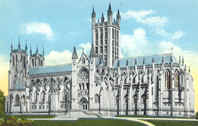 |
| National Cathedral |
President Roosevelt at Church. One Sunday we all went to the National Cathedral. It was being built, but the main part was in use. President Roosevelt sat in the front, middle section down in front. When the service was over, all was quiet and the President was assisted up and we could hear his braces being clicked into place. The congregation stood up and the Secret Servicemen came running in all directions. One nearly knocked me down in his haste to get to the President’s side.
Living at the YWCA Was Quite an Experience. The "Y" was an old building. There was a porch all around the first floor. There were five floors. I lived on the fifth floor in a small room. It was very cold. The bats flew all around and the janitor came up with a broom and swished them out.
The Oxford Group: Waiting for God to tell roommate what to do. My roommate was young and from the Bronx, New York. She belonged to a religious group called the Oxford Group. I believe it started in England. She would set her alarm for six a.m. It would wake me up hours before I needed to get up. She got out of bed, took a tablet and pencil and sit in the corner. She was waiting for God to tell her what to do that day. Many times the girls at the "Y" would invite her to go to the movies. If God said "no" she would not go.
I went to New York City with her one cold weekend. We got off the train at Grand Central Station. Her parents ran the "Milk Bar" in the station. We rode the Subway and Elevated. I saw the Empire State Building. It was too cloudy to go up and see anything.
Birthdays. They come and go. And many of us would rather they never came. But time marches on and the years pile up. Aunt Bessie had a cake baked for me on my fifth birthday. I remember it so well. It was small, but it had butter icing and lots of purple forget-me-nots all over it. It was not a real party, just Aunt Bessie, her friend, Mrs. Reese and myself. That was the only time anyone ever remembered my birthday as a child. My first birthday after my Mother died. July 9th. 1923. Aunt Bessie’s son’ birthday was on the 15th. They always said we’d celebrate his and my birthdays together. But I never got any presents then either. That is why, when I grew up, I tried to remember birthdays of all my family and friends.
 |
| U.S. Capitol Building |
The Capitol Dome. Every time I see the Capitol on television or in the newspapers, I get a warm feeling of pride. The Goddess of Freedom stands tall and symbolizes our country.
The Goddess of Freedom … was put up there by a group of men who worked for the Bethlehem Steel Company. My grandfather was one of them. His name was William H. Mawrey. His name is unusual, having a "w" instead of the typical "u." His parents came over to the United States from England in the early 1800’s and settled in Petersburg, Virginia. He was born there in the 1830’s and married Margaret Charlotte Redmond. They had eight children.
He traveled around a lot. Several children were born in Washington, D.C. My mother was born in Wilkes Barre, Pennsylvania. Aunt Elsie was born in Charlotte, S. Carolina. My grandfather died in Washington, D.C. in 1899. My grandmother died in 1912, so I never got to know them. I was born in 1914.
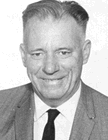 |
| Albert P. McCabe |
Albert Philip McCabe. I met and married Albert (Mac) November 16, 1936. We met through my best friend Aimee Arseneau, who I later named our first daughter after. We were very much in love. He was studying to be an engineer and I worked for the government in the Resettlement Administration Department. I worked there for six years putting Albert through school. We had begun to think that we could not have children. So we bought a brand new 1941 Chrysler and guess what? I became pregnant with Aimee Louise. She was born January 22, 1942.
My First Airplane Flight. 1945. I flew to Seattle, Washington with three and a half children. Aimee, age 3, John, age 2 and Linda, age 10 months. I was pregnant with Michael who would be born in Seattle October 27, 1946. Mac, my husband, had flown out earlier. He had a terrible time finding us a place to live. Then he had a bad reaction from a smallpox vaccination. So it was February to May before we could go.
I sold all of our belongings. I only sent what we needed. Boeing, where he went to work, did not pay our expenses. So I had to get $334.04 to pay for our tickets. Full fare for Aimee, John and myself. Linda was free because she sat on my lap. She was 10 months old.
We Flew to Chicago on a DC-3. After a three hour wait we took a DC-4 and flew to Boise, Idaho Airport. From there we flew over Salt Lake City, Mt. Adams, Mt. Hood and Mt. St. Helens. We had no fold down trays as we do now on planes. The stewardess put a pillow on our laps to place the trays of food on. Then flying over Mt. Rainier at sunrise was a sight to behold. Orange, gold and red ... made it look like an ice cream sundae. When we were living on Rainier Avenue in Seattle, we could see Mt. Rainier on a clear day. It is a spectacular vista.
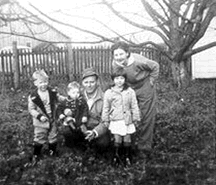 |
| The McCabes, 1948 |
We Lived in Seattle and Then Kent, Washington. We moved to a ranch in Kent, which is about 20 miles from Seattle. The house was in the middle of 60 acres. The owner leased the land out to cattle ranchers part of the year and grew alfalfa the rest of the year. There were over 50 fruit trees, mostly apples of many varieties and some peach trees, pears and plum and even a filbert tree or two. Ms. Lillian Olson, the owner, also had a tea house in Seattle. She used the fruit to make desserts for her customers. We were allowed to use all the fruit we could eat.
Wood Stove, Fireplace and No Neighbors. There was a large red barn where bales of hay were kept. The house had only electricity. No heater. Only a fireplace and a wood stove. I had to learn to chop wood in order to keep the place warm and to cook food. My daughter, Aimee and son, John began school in Kent. They had to take the bus to and from school. We had to listen to the radio on stormy mornings because when the roads were too icy, schools were closed.
When we moved to the ranch in Kent, Washington, I had never had to chop wood. I cooked on a 1910 model wood stove, with a hot water tank attached. The heat from the stove would heat the water. The stove also had a warming area on top. I had to chop wood to keep the stove and the fireplace going. We ordered a cord of fire wood and I had to chop each piece into three parts. So it would fit in the wood stove.
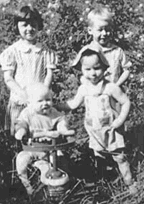 |
| The McCabe kids |
The fire was started and coffee, oatmeal, eggs were cooking when the family trouped in to eat breakfast. Aimee and John would eat and run out to the road and wait for the school bus. (Unless the radio said no school today.) Linda and Michael would play until Aimee and John came home from school.
High Tree Stumps. I remember the time Aimee and John decided to take Linda for a walk to Mt. Rainier. They got to the end of the property and turned around to head back home. Once Aimee climbed to the top of a very high tree stump to pick blackberries. She couldn’t get back down. John came and got me and took me to her to help her down. In those days, lumbermen cut trees pretty high off the ground and left the high tree stumps.
Wasps, Yellow Jackets and Bees on the Property. The wasps would build their nests outside our door. I had to discourage that. I would take the hose and knock down their nest. Guess that was dangerous. But they were attacking the kids whenever they would go outside. Red ants would build their anthills out in the fields too. Once in awhile Aimee or John would be running in the tall alfalfa grass and step right into one. I would have the hose ready to squirt the ants off of them. Once Aimee got stung by a bumble bee. She was running around barefoot and stepped on one. There were clovers everywhere. Bees like clovers.
We Used to Go to Lumberjack Events Too. The lumberjacks would climb up poles and have a race to see who could cut the top off first with chainsaws. Also they would have wrestling events while balancing on floating logs.
Fresh Fruit. Mac went to work at Boeing early, while it was still dark to drive the 25 miles. It was dark when he returned home from work. So I had all the wood chopping to do during the week. He did the chopping on the weekends. With all the fruit trees around the house, I had lots of canning to do. There were Delicious apples, Gravensteins, Winesaps, Early Green Apples, Banana Apples, Yellow Delicious Apples, Wolf Apples, Crab Apples and several varieties of pears. I would also halve, core the apples and put brown sugar and butter on them and bake them.
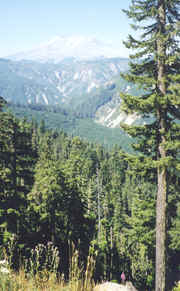 |
| Mt. Rainier today |
We Had a Front Porch Facing Mt. Rainier. And rocking chairs. Every so often a Finnish couple would walk up our long driveway and sit in the rockers and rock to and fro and never say a word. I would offer cookies and coffee and Mac would offer beer or bourbon. They would accept it all and rock some more. Then bow and go home. This was the extent of neighborliness in Kent, Washington. We did have a nice neighbor across the way. Mr. Lamb who had a big garden. He gave us vegetables. His wife raised ponies. She made it clear that she did not like children.
One day, our daughter, Linda insisted that Mrs. Lamb invited us over to ride the ponies. I doubted it, but to please her and Aimee, John, and Michael, (asleep for his nap). I washed their faces and hands and put on clean clothes and we went down our driveway and across the road. Linda, being more social minded than the rest of us, knocked on the front door. We got an icy stare and she said "what are you doing here?" So we wended our way back home. They couldn’t understand it at all. So I made cocoa and we had our little party.
I Never Drove a Car. Mac tried to teach me once, but I was not comfortable with it. So Mac would buy groceries on his way home from work. The nearest doctor was in Renton. There was nothing in Kent in those days. The children were never in a store until we lived in California. 1951.
Outsiders Are Not Welcome. It was very hard to be accepted. Newcomers were not welcome. Even the teachers were not very nice. Aimee had a hard time because she was new and also because of the spelling of her name. Perhaps they felt her name should have been spelled the "American" way. But as I get older, I realize most people do not like new people to come into their lives.
4th of July Picnics. Mac belonged to the Volunteer Fire Department. On July 4th there was always an all you can eat picnic. Hot dogs, ice cream, soda pop. And of course fireworks. Everyone had a good time. At home on the ranch, Mac sometimes would bring home fireworks and he and the children would set them off near the barn. Cherry bombs were thrown at the barn and exploded. Once Mac put little firecrackers into the wood stove before I got up. When I started the fire to begin cooking breakfast the firecrackers all went off. What a joker.
Christmas Party for the Children. This too was put on by the Volunteer Fire Department. There was a Santa and presents for all the children. Very nice time.
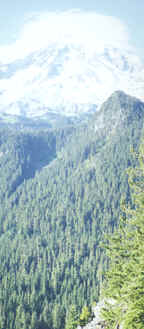 |
| Snow-capped Mt. Rainier |
Breakfast at Mt. Rainier. In the summer we would pack a breakfast and go to Mt. Rainier. I would fix bacon, eggs and toast. There were picnic tables and lots of room for the kids to play. Once we had bread on the table and Blue Jays began coming down one at a time and taking one piece of bread at a time. We let them take half of the bread. The children were very interested in watching the birds so cleverly taking the bread. On our way home from Mt. Rainier we once saw a very large dead grizzly bear on the hood of a pickup truck. We also used to find real Indian arrow heads on the trails at Mt. Rainier. Little did we know that we were living the past. I guess we are now too.
Hunting. Mac was invited to go hunting with his pals at work (Boeing). He came home and told us all that he could have shot and killed a deer and a rabbit. He said he couldn't do it. He looked at their eyes and felt sick about it. How could anyone kill a beautiful, harmless animal? That conversation stuck with the children. None of them are hunters or approve of killing animals. In fact, Aimee, our oldest, is a strict vegetarian today.
Earthquake! There was a big earthquake in the Seattle area. Many windows in the Boeing building were shattered. The children and I were home. We saw the water heater swaying back and forth. I looked outside and saw the electric wires swinging like jump ropes. The cows all went wild and jumped the fences. Special cowboys were called in to round the cows up. One cowboy was hanging onto a cow’s tail and being pulled around.
White Center, Washington. Later after moving back to Seattle our home was in section called White Center. Our home sat on a ridge where we could see the Olympic Mountains from our dining room. What a view. Snow capped mountains, range after range. I counted five ranges, as far as my eyes could see.
One day, the radio said a storm was coming. I could see it coming in from the Olympic mountains. I called my husband to hurry home. The storm was coming closer and closer. He had left the car in the garage under the house that morning. He took the bus and had to walk. The snow was piling up and it was hard to walk through it. It was so dry his clothes did not get wet. Someone wrote in the newspaper that it was the most perfect snow. The snowflakes were perfectly shaped.
And of course the snow piled up against the garage door and it was weeks before he get the car out to drive it again. We had to order coal and not being able to put it in the basement, they dumped it on the hillside in the snow.
On Saturday’s we would go to the movies. Nine cents for two full length movies, cartoons, the news and a Flash Gordon serial. The theaters in those days had a glass room to take crying children into so as not to disturb other movie goers. You could watch the movie from there until the child stopped crying or you could simply stay there and watch the movie.
We had the Conradi’s for neighbors. Doris and Chris. We would go over on Saturday evenings and play cards. Pinochle or Canasta and share refreshments. We lived in White Center from 1949 to 1951. Doris remained my friend forever. We corresponded regularly. We had remodeled the house. Put tile floors and new bathroom. All baby blue fixtures and installed an aluminum garage door. Dad & I worked as a team. He painted the outside all white and dark green trim. He was painting until the day we left. We rented the house until it became too expensive to be absentee landlords. We sold the house. The house and the neighborhood is still there and looks the same. Aimee visited Seattle in 1994. She took some photos of the house.
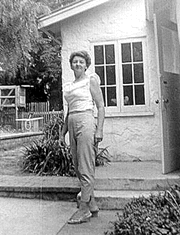 |
| Elizabeth McCabe |
To Los Angeles, California, 1951. Mac began working for Northrup in Los Angeles. We found a home near the Los Angeles Coliseum. There were palm trees and the houses all had front porches. There was a neighbor family next door that encouraged their son who was the same age as John to practice KungFu type fighting on John every time he came out of the house. Another neighbor had a German Shepard that although he was behind a high fence, his owners said that he would attack anyone who so much as carried a stick.
Aimee liked to roller skate up and down the sidewalks. She had friends who lived a few houses away. They would sit on the porch and crochet. She would crochet doilies and sell them to neighbors for a dollar. And then buy more thread to crochet more.
We were close enough to walk to the Coliseum. During big events, some people would rent their driveways for parking to people who went to these events. One day they had a big rodeo. We all went to one of the events, a rodeo. Cowboys were on their horses and we walked, by all six of us, waiting to get in. One cowboy leaned over his horses neck and said "You look like a nice family" and gave us tickets to go in free.
No TV. A neighbor had a color television. We were invited to sit and watch the coronation of Queen Elizabeth. We did not buy a television until we lived on Chapala Street in Santa Barbara. Even then, it was not a big part of our life. The children spent their days outside playing.
July 4th Blue Angels. We went to see the fireworks at the Coliseum one fourth of July. We were sitting pretty near the top of the stadium. When it got dark, we were all asked to light a match. Quite a sight. Then the Blue Angels came out of nowhere and swooped into the stadium and out again with the most thunderous noise one could imagine. One man had a heart attack. Michael nearly fainted from the noise. They never let the Blue Angels do that again.
Schools in East Los Angeles. The children were just about the only white kids in the school. They seemed to adjust well. The other children were well behaved and well dressed. Aimee went to birthday parties and piano lessons with friends from the school. Michael did have a black teacher who did not like white boys. But she changed after a while.
To Pacoima, California. We bought a home in Pacoima, in the San Fernando Valley. Very nice house on a corner lot. A grade school was just across the street. Aimee and John liked to ride their bikes in the school yard. In those days, the schools were not locked up. They even had summer events for children.
All was well until Aimee had to go to Pacoima Junior High School which was over a mile away. She had to walk the distance to and from school. This school was predominantly Spanish-American. The kids were very rough. The school allowed, or least it didn’t object, to students chasing after new students entering the 7th grade and putting red lipstick all over them. There were gangs of boys that beat others with bike chains, knives and razors after school or in the restrooms. No guns or dope yet. The girls were rough too. One girl named Josie took a dislike to Aimee and began threatening her with violence. Aimee was frightened. We moved from Pacoima to Santa Barbara. Mac was going to work for Vandenburg.
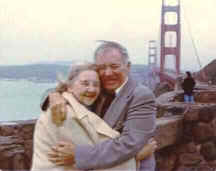 |
| Albert and Elizabeth, Golden Gate Bridge circa 1981 |
Santa Barbara, California. What a difference. So lovely. Beaches and mountains. A nice downtown and buses. We rented a house on Chapala Street. It was a Spanish style house which sat back from the street. The round dining room had murals painted on the walls. Wrought iron railings curved up the stairs. But no electric outlets. It was a pretty house though. Aimee and John went to LaCumbre Junior High School on Modoc Road. They took the bus or walked. Aimee liked to say "from Fats Domino to Pat Boone". Much nicer school and environment. No violence. Much safer. Linda and Michael went to a grade school nearby. We lived there until we moved to 288 N. LaCumbre Road, a little further north of town.
La Cumbre Road, Santa Barbara, California. What a big house. Two stories on almost 3 acres with a cemetery adjoining the property. There were lemon trees across the street, covering blocks and blocks of land. No homes yet. The shopping center down the road on State Street and LaCumbre Road was a walnut grove then. There were no traffic signals. Just a Stop sign on the corners. There were no stores nearby except for Kelly’s Corner which was a small grocery store.
At this time, Mac was working for Vandenburg. He was only home on weekends. He was also thinking of starting his own business in the aeronautics field. He had invented a device which would detect if a plane was too near. This would prove to be too expensive to sell. He and Howard Stark, his partner, would eventually lose the rights to the invention. They sold the business. There was not much profit as we owed a lot of money to this project. Rather than go bankrupt, Mac paid back every cent of his debt. This took years.
The children grew up, and went out into the world. Mac and I went to Nutley, New Jersey for a year or so. Mac worked for ITT. We had a nice apartment. On weekends we took a bus to New York City and rode the subway to downtown. We really enjoyed living near New York. When the job ended, we moved to Redondo Beach, California. Mac loved the Pacific Ocean. We walked to the beach almost every day. We enjoyed each day. Mac passed away in his sleep on June 27, 1987. He is dearly missed.
I Moved to Portland, Oregon. I lived with Linda for a short spell. It was too cold for me. Aimee and Richard picked me up and moved me into a really nice studio apartment near them.We had nice times together. They took me out for drives, out to lunch, etc. They eventually did my shopping for me. My legs became too weak to do much walking. It was hard on Aimee and Richard as they both worked long hours.
Friday Harbor, Washington. We decided that I really needed to be with someone during the day. So I moved back to Linda's. She lived in Friday Harbor, Washington. She has a large home. I am well taken care of here. Linda and her husband, Tom, are very good to me. I miss Aimee and Richard but understand why this came to be.
[Aimee's note -- Elizabeth Irene Bryan-McCabe passed away on January 3, 1996. She is dearly missed by all of us. She had quite a life.]
Copyright © 1997 Aimee L. McCabe-Walker. Republished with permission.